
94% of researchers rate our articles as excellent or good
Learn more about the work of our research integrity team to safeguard the quality of each article we publish.
Find out more
ORIGINAL RESEARCH article
Front. Earth Sci., 12 July 2023
Sec. Quaternary Science, Geomorphology and Paleoenvironment
Volume 11 - 2023 | https://doi.org/10.3389/feart.2023.1233959
This article is part of the Research TopicCurbing Carbon Emissions: Insight from the Ecosystem Evolution During Ancient Hyperthermal EventsView all 7 articles
A correction has been applied to this article in:
Corrigendum: Geochemical characteristics and hydrocarbon generation potential of main source rocks in the Upper Triassic Xujiahe Formation, Sichuan Basin, China
In order to have a comprehensive understanding of the characterization and hydrocarbon generation potential of the source rock in the Upper Triassic Xujiahe Formation, Sichuan Basin, the geochemical data of more than 1,500 cuttings and 106 core samples were collected and analyzed. The T3x5 member of Xujiahe formation show the highest average TOC content (3.63%) followed by the T3x1+2 and T3x3 members. The TOC contents of different members show a general decreasing trend from the bottom to the top in Xujiahe formation. From the rock pyrolysis and kerogen δ13C values, the source rock trend to be kerogen type III with minor amounts of type Ⅱ2. According to the Ro values, the Xujiahe source rock shows high maturity in the northwest and low maturity in the southeast. Most of the source rock in T3x1+2 members are in high to overmature stage, while most of the source rock in the T3x3 and T3x5 member are in the mature to high mature stage. By comparing the burial history and hydrocarbon generation evolution history of source rocks in central and western Sichuan basin, it can be found that the sedimentation rate differences during the Cretaceous period is the main cause of the thermal evolution difference of the source rock. The gas generation intensity and quantity of different members are also compared. The T3x5 member show the highest gas generation potential followed by the T3x31 and the T3x1+2 members. In general, horizontally, the source rock of Xujiahe formation in Sichuan Basin is characterized by great thickness, high maturity, and high gas generation intensity in the northwest, which are gradually decrease to the southeast. Vertically, the T3x5 member show the highest gas generation content, which account for 39.6% of the total amount.
Natural gas exploration in the Upper Triassic Xujiahe Formation in Sichuan Basin began in the early 1950s (Zhao et al., 2010; Zheng et al., 2019b). The exploration has experienced three stages: the structural gas reservoir exploration, lithologic gas reservoir exploration and tight gas reservoir exploration. Although the exploration results of Xujiahe Formation are remarkable, the utilization rate of the reserves is low, the production wells are characterized by large difference in production capacity, rapid decline in production and low proportion of efficient wells (Zheng et al., 2021). In addition, the exploration interest mainly focused on the western Sichuan foreland basin and the depression belt in the central parts of the basin, and the exploration degree of the slope belt is low (Qin et al., 2018a; Qin et al., 2018b; Li et al., 2019; Wang et al., 2020). Most of the previous work are mainly focused on the reservoirs in Xujiahe formation (Li et al., 2019) and Few studies have been conducted on the comprehensive evaluation of the Xujiahe Formation source rocks in the whole basin (Deng et al., 2012; Wu et al., 2017; Zheng et al., 2019a; Deng et al., 2019).
In order to realize the large-scale effective exploration and development of the Upper Triassic Xujiahe Formation, it is necessary to carry out a comprehensive and systematic analysis of its source rocks. In this study, the organic geochemical information of more than 1,500 cutting samples from Xujiahe Formation were collected, another 106 core samples have been subjected to TOC and pyrolysis analysis, the characteristics including the abundance, type and maturity as well as the vertical and horizontal distribution of organic matter were thoroughly studied. The gas generation intensity and quantity of different members was evaluated and compared to provide guidance and reference for further exploration of Xujiahe Formation in Sichuan Basin.
Sichuan Basin is a large rhombic basin located in the western region of Yangtze plate, covering an area of about 18 × 104 km2 (Li et al., 2014; Mu et al., 2019). The basin is surrounded by Longmen Mountains to the west, Micang Mountains and Daba Mountains to the north, Daliang Mountains and Dalou Mountains to the south and Qiyue Mountains to the east (Cheng et al., 2021). As one of the large superimposed petroliferous basins, the basin has undergone two stages of evolution: the Sinian-Middle Triassic craton basin and the Late Triassic Cenozoic foreland basin. Among them, the Sinian-Middle Triassic is Marine strata, mainly carbonate rocks; The Upper Triassic—Cretaceous is mainly terrestrial strata (Tong et al., 1990). According to the structural characteristics, the inner basin can be subdivided into six sub-structural units: north Sichuan low gentle structural belt, west Sichuan low gentle structural belt, middle Sichuan gentle structural belt, southwest Sichuan low steep structural belt, south Sichuan low steep structural belt and east Sichuan high steep structural belt (Figure 1).
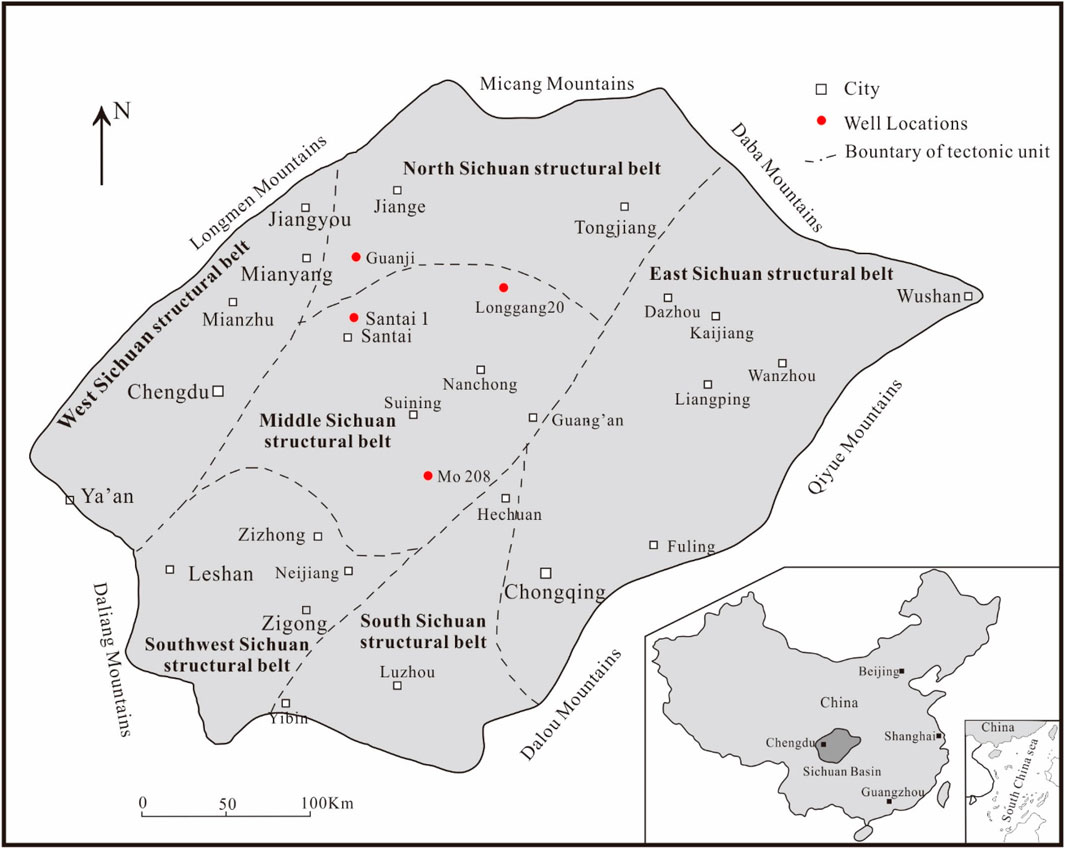
FIGURE 1. The tectonic units of the Sichuan Basin, modified from (Dai et al., 2012).
The Upper Triassic Xujiahe Formation in Sichuan Basin was dominated by terrestrial deposits. The thickness of the Xujiahe Formation is macroscopically controlled by the basin structure and sedimentation. The thickness of the west Sichuan foreland depression zone is the largest, and the thickness varies greatly, ranging from 2,000 to 4,000 m (Deng et al., 2019). The thickness gradually thinning out from the northwest to the southeast in general. According to the latest stratification scheme (Wang et al., 2021), the Xujiahe Formation can be vertically divided into three second-order sequences and seven third-order sequences (Figure 2). The first, second, third and fifth members (T3x1, T3x2, T3x3, T3x5) are mainly composed of thick black shale, mudstone and coal seam, which are regarded as the most important source rocks. The fourth and sixth members (T3x4, T3x6) of Xujiahe Formation are the main reservoirs with thick sandstone and conglomerate interbedded with thin, layered mudstones (Dai et al., 2009; Dai et al., 2012). The superimposed combination of multiple source rock and reservoir formations is conductive to hydrocarbon accumulation. In this study, specific analysis will be made for the source rock segment.
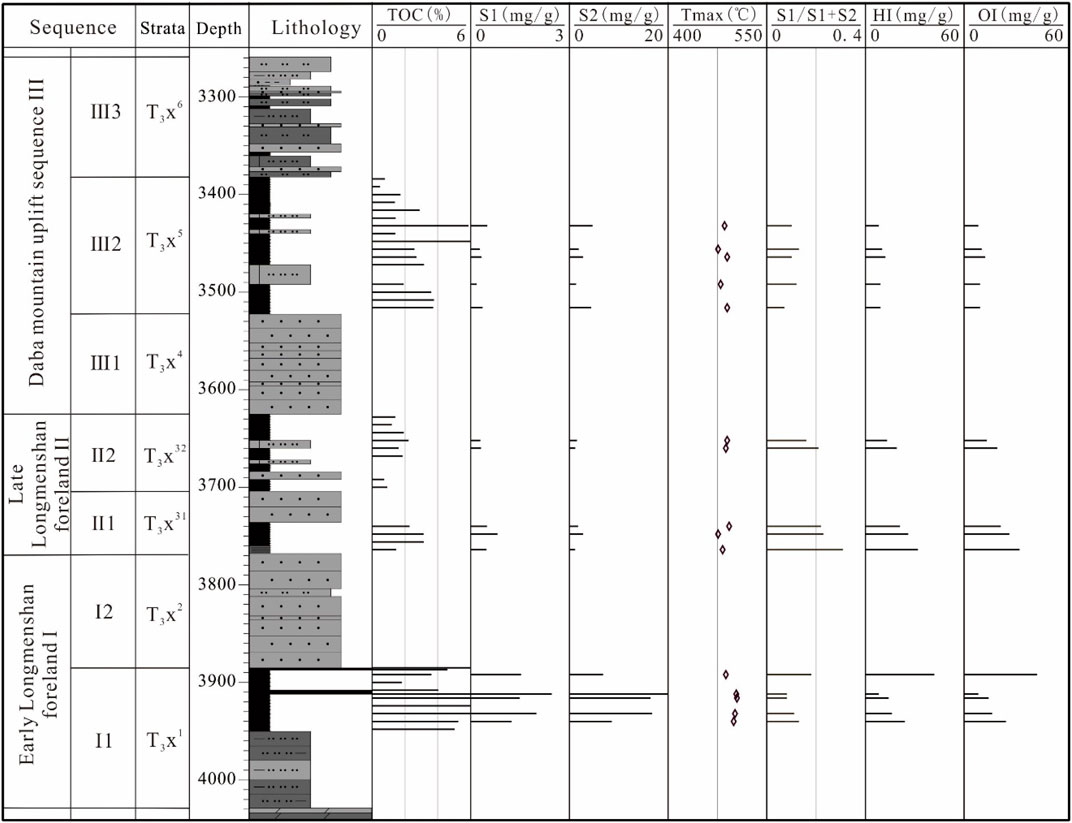
FIGURE 2. Stratigraphic and geochemical characteristics of source rock from the Xujiahe Formation in Longgang 20 Well (the location of the well can be found in Figure 1).
In this study, the TOC values of more than 1,500 cuttings were collected. Additionally, 106 core samples collected in different strata of Xujiahe Formation were subjected to geochemical test and analysis in PetroChina Research Institute of Petroleum Exploration and Development- Langfang (RIPED-Langfang). TOC analysis was carried out by CS-200 carbon and sulfur analyzer. Pyrolysis analysis was performed by Rock-Eval 6 pyrolysis apparatus. Vitrinite reflectance (Ro) was determined by MPVIII microphotometer and an oil immersion lens. Kerogen was subjected to stable carbon isotope values analysis by Thermo Finnigan Mat Delta S mass spectrometer interfaced with a HP 5890II chromatograph also at RIPED-Langfang. The measurement precisions for δ13C were estimated to be ±0.3‰.
According to the deposition time, formation lithology, formation thickness, denudation time and thickness, paleo-water depth, paleo-heat flow and the geological tectonic setting, the PetromodTM v2016.2 software system of Schlumberger was used to model the burial history, thermal evolution history of a single well. In addition, the model is calibrated by comparing with the measured vitrinite reflectance values.
The total organic carbon (TOC) content of more than 1,500 samples from Xujiahe Formation in Sichuan Basin were collected in this study. In general, the TOC content is mainly distributed between 0.5% and 4% (Figure 3). The highest TOC content is up to more than 75% and the average TOC content is 2.83%. About 70% of the measured samples had TOC content greater than 1.0%. The distribution of TOC content indicates that the source rocks in the study area are mainly high-quality source rocks. In terms of lithology, the source rocks are mainly mudstone, carbonaceous mudstone and coal, among which mudstone is the main source rock, accounting for 90.8%, carbonaceous mudstone and coal are 8.4% and 0.8%, respectively.
Vertically, source rocks are developed in all strata. The TOC content of 433 samples from T3x1 and T3x2 members (T3x1+2) ranges from 0.28% to 75%, with an average of 2.9%. The TOC content of 223 samples in the lower section of T3x3 member (T3x31) were between 0.3% and 31.9%, with an average of 1.64%. While the TOC contents of the 322 samples in the upper section of T3x3 member (T3x32) ranged from 0.39% to 71.4%, with an average of 2.35%. The TOC content of 583 samples in T3x5 member were between 0.33% and 45.2%, with an average of 3.63%. From T3x1+2 to T3x5 member, the number of samples with TOC content greater than 4% increased from 16.4% to 22.5%, while the number of samples with TOC content less than 1% decreased from 34.4% to 12.9% (Figure 4). From bottom to top, the proportion of source rocks with high TOC values increases gradually, and the quality of source rocks becomes better.
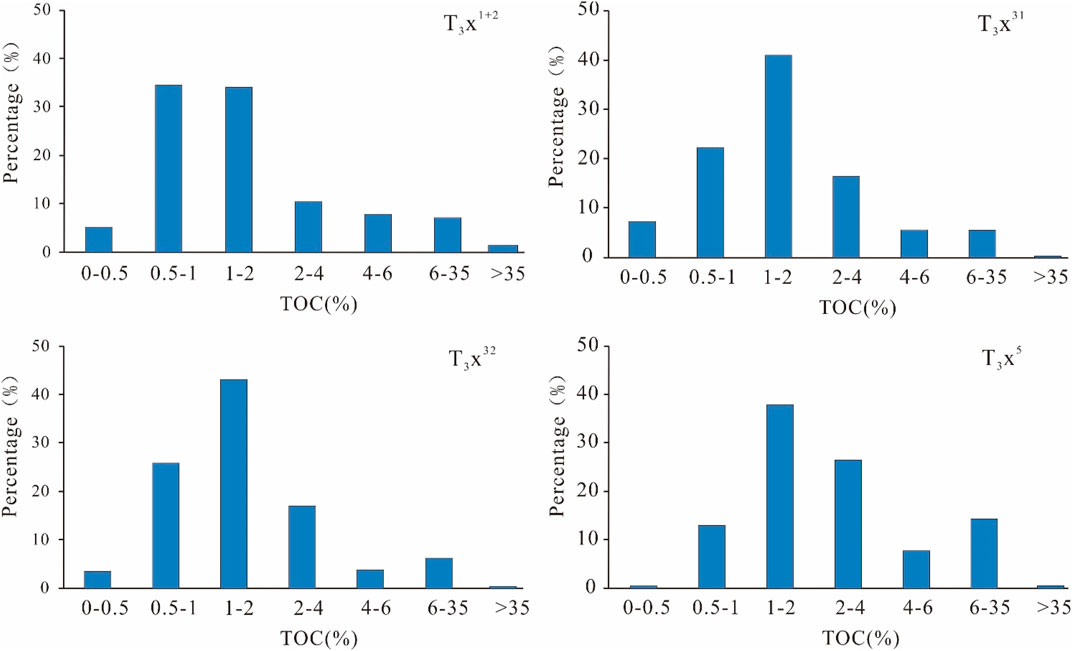
FIGURE 4. TOC distribution column diagrams of main source rock members in Xiajiahe formation of Sichuan basin.
Horizontally, the source rocks with high TOC values from T3x1+2 members are mainly distributed in the western Sichuan depression. There are several high value areas in middle and north Sichuan structural belt, but the distribution range is small. The source rocks of the lower and upper members of T3x3 are mainly distributed in the southern part of western Sichuan depression, northwest and north Sichuan structural belt. The distribution area of TOC content greater than 3.0% is relatively wide. The areas with high TOC values are much larger than that of T3x1+2 members. There are several areas with high TOC values in the T3x5 member, which are developed in most areas of the western Sichuan depression, central and northern Sichuan, and samples with TOC content greater than 3.0% are widely distributed. The distribution area of TOC greater than 1% in the basin is also relatively large, accounting for more than 80% of the stratigraphy distribution range. In short, the T3x5 member show the highest potential for hydrocarbon generation in terms of TOC content and the distribution range.
The T3x4 and T3x6 members are mainly sandstone deposits with mudstone developed in some areas, thin coal seam and carbonaceous mudstone can also be found. These two members have certain hydrocarbon generation potential.
Based on the pyrolysis results of more than 100 samples of Xujiahe formation, the intersection diagram of kerogen hydrogen index (HI) and maximum pyrolysis peak temperature (Tmax) was presented (Figure 5). The organic matter types of source rocks in each section were analyzed and evaluated. It can be seen that the hydrogen index (HI) content of source rocks in Xujiahe Formation is mainly distributed between 20 and 200 mg/g, and the Tmax values are mostly distributed in the range of 410–480°C. Most of the samples were kerogen type III and only a small number of samples were biased towards kerogen type II2.
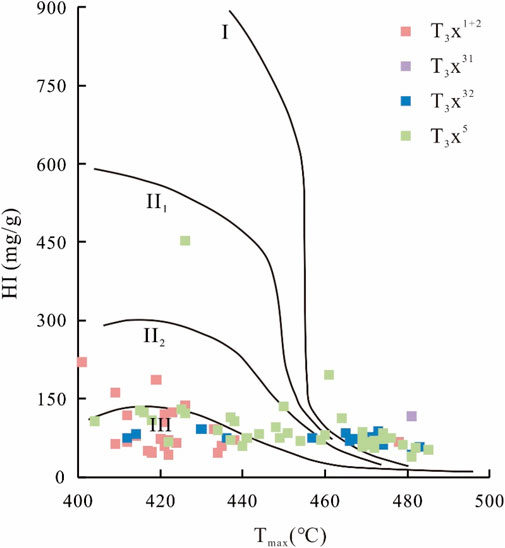
FIGURE 5. Intersection Diagram of HI and Tmax of source rock from Xujiahe formation in Sichuan Basin.
The carbon isotope composition of sedimentary organic matter mainly depends on the source of organic matter, and is less affected by maturity. The δ13C value of kerogen varies only by 1‰ from immature to mature. Therefore, the stable carbon isotope value of kerogen can be used as an effective parameter to determine the type of organic matter. The δ13C values of kerogen carbon isotopes of Xujiahe Formation source rocks in Sichuan Basin range from −27.5‰ to −23.5‰, of which 83.7% samples are greater than −26‰ and 16.3% of source rocks range from −26.5‰ to −27.5‰ (Figure 6). According to the standard of classifying organic matter types by carbon isotopes proposed by Huang (Huang et al., 1988), type II2 kerogen show carbon isotope between −28‰ and −26‰ and type III kerogen show carbon isotope above −26‰. It can be observed that most source rock samples of Xujiahe Formation belong to kerogen type III, and only a few samples belong to type II2. The kerogen type identified by carbon isotopes is consistent with the rock pyrolysis results.
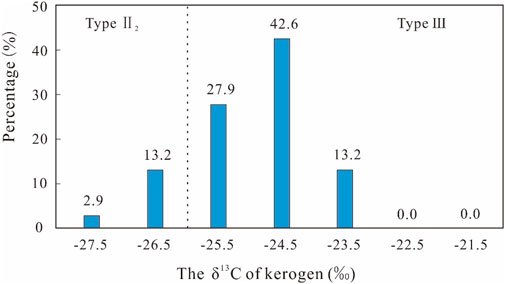
FIGURE 6. Histogram of δ13C distribution of source rock kerogen in Xujiahe Formation, Sichuan Basin.
The organic maturity of source rocks can be accurately calibrated by vitrinite reflectance (Ro) (Bai et al., 2017; Cheshire et al., 2017; Liu et al., 2020). Based on the Ro data of different strata in Xujiahe Formation, the maturity of source rocks in Xujiahe Formation is analyzed by adding new test results.
The source rocks in the western Sichuan basin are high mature to over-mature, and the Ro value of T3x1 member is the highest, which can reach 2.6% in the Mianzhu area. The Ro value of the source rocks gradually decreases from this center to the surrounding areas, but all are above 1.0%. The source rock maturity of Jiange-Jiulongshan area is also high, with Ro value reaching 2.0% (Figure 7). The Ro value of source rock in T3x3 member is between 0.8% and 2.0%, which is lower than that of the T3x1+2 member. Among them, the Ro value in the Mianzhu area is still the highest. The Ro value of Jiange—Jiulongshan area is between 1.6% and 1.8% (Figure 7). Most of the source rocks in T3x5 member have just reached the high mature stage, with Ro values mostly ranges from 0.8% to 1.4%. Most areas in the northwest Sichuan basin were denudated, and the source rock in Chengdu area in southwest Sichuan has the highest thermal maturity in the whole basin, with Ro value reaching 1.6%. In the central Sichuan basin, except the Ro value of T3x1 member is high, the T3x3 and T3x5 members also reached the gas window with Ro values between 1.2% and 1.4%. The Ro values of the source rock in the other parts of the basin are around 1.0%.
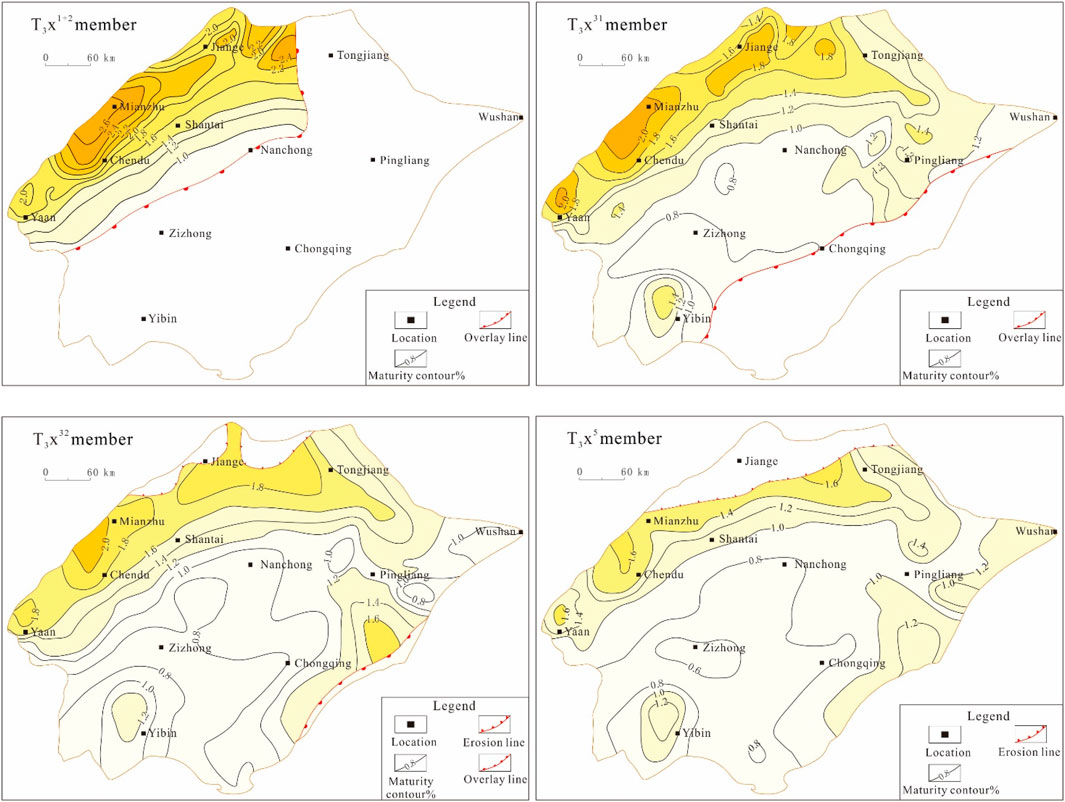
FIGURE 7. The contour maps of RO values of source rock from different members of Xujiahe Formation in Sichuan Basin.
The thermal maturity of source rocks in Xujiahe Formation is related to the tectonic style and burial depth of strata, which is affected by Indosinian Movement and Yanshan Movement (Wang et al., 1997). The strata of Xujiahe Formation were thick in northwest and thin in southeast at the end of Yanshanian period. Therefore, the source rocks thermal maturity of the Xujiahe Formation in the northwest of Sichuan basin is significantly higher than that in the southeast. All the source rocks in the Upper Triassic Xujiahe Formation of Sichuan Basin have reached the mature stage. The central and western Sichuan basin has a high degree of thermal evolution, most of the source rocks have reached the gas window, which is the basic condition for large-scale gas generation and accumulation.
In order to accurately reveal the hydrocarbon generation characteristics of source rocks in the study area, the Mo 208 Well in the central and Santai 1 Well in the western Sichuan basin were selected. The basin simulation software system PetromodTM v2016.2 was used to reconstruct the burial history, thermal history, maturity history and hydrocarbon generation history of Xujiahe formation.
The key parameters of burial history recovery include formation time, formation thickness, lithology, denudation thickness, etc. Among them, formation thickness is mainly obtained from drilling stratification data. The stratigraphic age is obtained according to the standard stratigraphic age table. The lithology data is processed by mixed lithology according to the lithology of each interval, which is determined according to the logging data. The degree of thermal evolution mainly changes with the in situ temperature and burial duration, which is the main factor affecting the hydrocarbon generation evolution history of source rocks. The evolution of heat flow in northern Central Sichuan Basin (Wang et al., 2014) and the Northwest Sichuan Basin (Huang et al., 1990; Yang et al., 2004) have been studied before. In this simulation, the Easy% Ro model proposed by Sweeney (Sweeney and Burnham, 1990) was adopted, and the paleo heat flow value was corrected by referring to previous research results until the calculated Ro value reached the best fitting state with the measured Ro value (Figure 8).
The burial history and thermal evolution history of source rock in different areas of Xujiahe Formation was reconstructed (Figure 9). The main characteristics of hydrocarbon generation history in the central Sichuan Basin are quite similar. In the middle and Late Jurassic (175–140 Ma), the central Sichuan Basin has experienced a rapid subsidence and a large rise in geothermal temperature. In the late Jurassic (140–135 Ma), there was uplift and denudation of the strata and a sudden drop in geothermal temperature. Correspondingly, the gas generation is mainly concentrated in the late Jurassic (156.6–140 Ma). Thus, the Xujiahe formation in the central Sichuan Basin is characterized by a large amount of gas generation in a short time.
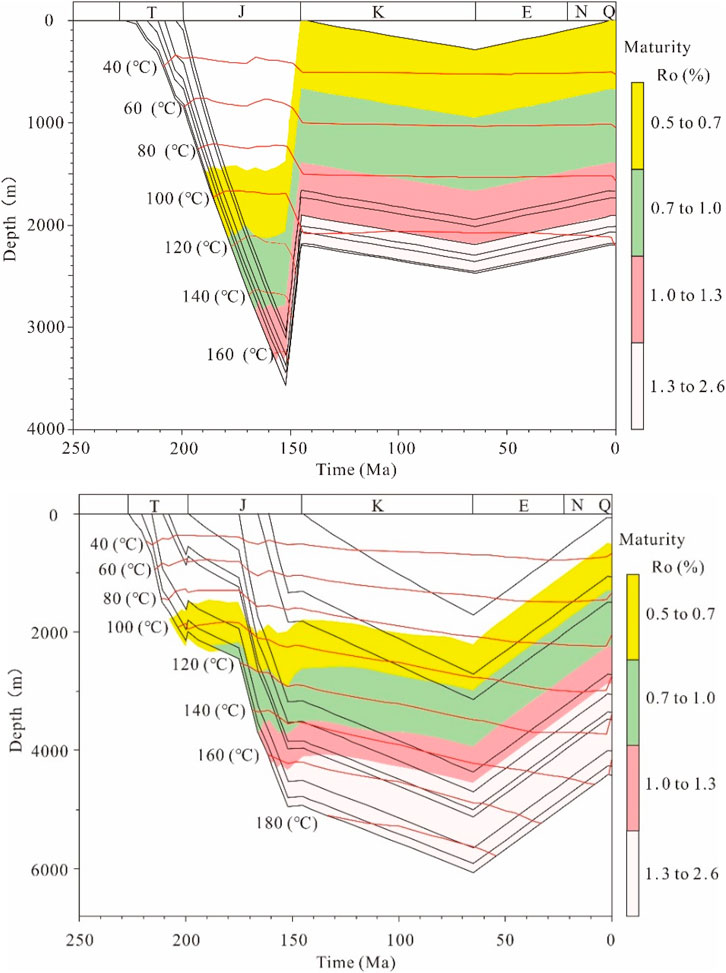
FIGURE 9. Burial history and thermal evolution history of Mo 208 Well (up) in the central Sichuan Basin and Santai 1 Well (down) in western Sichuan Basin.
In the western Sichuan Basin, the source rocks of Xujiahe Formation reached the threshold of hydrocarbon generation in the late Triassic to the early Jurassic. The Ro value was between 0.5% and 0.7%, only a small amount of early cracking gas was generated. The threshold depth of hydrocarbon generation is about 2100–2400 m. From the Early Jurassic to the Late Jurassic, organic matter reached maturity stage with Ro value between 0.7% and 1.3%. A large amount of cracking gas was generated, which started the primary migration and was preserved in the reservoir. From Late Jurassic to the end of Late Cretaceous, the Ro value is greater than 1.3%, the organic matter evolution reached the high maturity stage and entered the late gas generation stage, which was the key period of natural gas generation. After Tertiary, the overlying strata suffered denudation and the source rock buried depth decreased due to the influence of the Himalayan movement and uplift. The organic matter in most areas maintained the mature state of the Cretaceous period and continued to generate hydrocarbon. Only the organic matter in the central area of the western Sichuan Depression continued to evolve to postmature stage.
The source rock burial history and hydrocarbon generation history differences between the central and western Sichuan Basin is caused by the different subsidence during Cretaceous. The western Sichuan area had experienced significant subsidence and resulted in a high degree of thermal evolution. The source rock has reached the stage of high maturity to over maturity. While the source rock in the central Sichuan was still in the mature stage during Late Jurassic to Early Cretaceous due to the small subsidence range.
The gas generation intensity refers to the amount of gas generated per unit area, which is closely related to the TOC amount, the type, maturity and the thickness of the source rock (Wu et al., 2017; Zheng et al., 2019a; Deng et al., 2022). The gas generation intensity of main source rock from different strata of Xujiahe Formation in Sichuan Basin is shown in Figure 10.
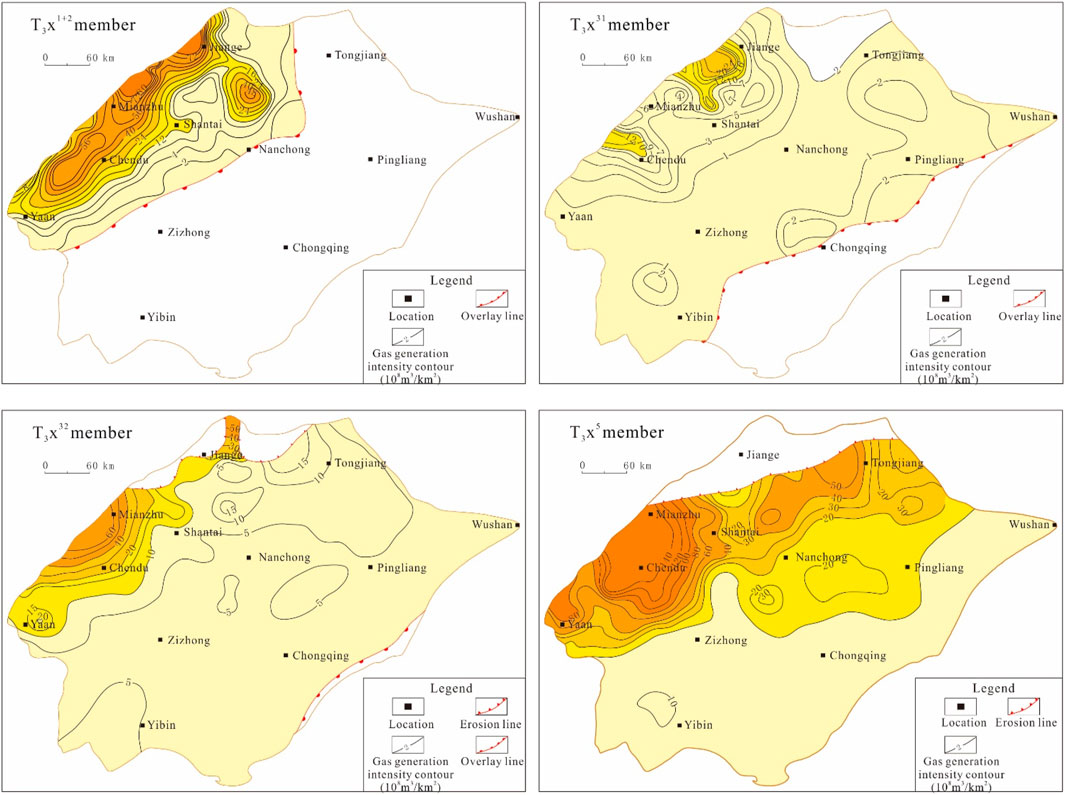
FIGURE 10. Gas generation intensity of source rock from different members of Xujiahe Formation in Sichuan Basin.
The gas generation intensity of source rocks in T3x1+2 members range from 2 to 80 × 108 m3/km2. The central of western Sichuan depression has a large gas generation intensity of (56–80) × 108 m3/km2. From the northwest to the southeast of the basin, the gas generation intensity gradually decreases. The area of source rock with gas intensity greater than 12 × 108 m3/km2 is about 2.6 × 104 km2. The T3x31 member show much lower gas generation intensity, which ranges from 1 to 24 × 108 m3/km2. Except two gas generation centers, most areas show gas intensity below 3 × 108 m3/km2. The gas generation intensity of source rocks in T3x32 member is much higher than that in T3x31 member. The highest gas generation intensity in this member is up to 60 × 108 m3/km2 in Mianzhu-Chengdu area. However, due to uplift and denudation, strata development in this area was limited and the contribution of hydrocarbon was small. The T3x5 member show the highest gas generation intensity. In central and western Sichuan Basin, the gas intensity is generally greater than 20 × 108 m3/km2. The highest gas generation intensity is up to 140 × 108 m3/km2 in the southwest part of west Sichuan depression. The area with gas intensity greater than 15 × 108m3/km2 is about 8.2 × 104 km2. This is significant to extensive gas accumulation in the Xujiahe Formation.
Generally speaking, the strong gas source rock center of Xujiahe Formation is located in the central and southern part of the western Sichuan depression, and the gas intensity is relatively low in the southern and northeastern parts of Sichuan.
According to the calculation, the total generated gas content of source rocks in Upper Triassic Xujiahe Formation of Sichuan Basin is about 685 × 1012 m3 (Figure 11). The generated gas content of the T3x5 member is the largest, which reaches about 271.6 × 1012 m3, accounting for 39.6% of the total gas content. The T3x1+2 and T3x32 members with generated gas content account for 19.1% and 19% of the total gas content, respectively. The generated gas content of the T3x31 member accounts for 9.3% of the total gas content. In addition, the T3x4 and the T3x6 member also have source rocks, the generated gas content account for 8.3% and 4.6% of the total gas resources, which also have a certain gas potential. It can be observed that the T3x5 member show the highest hydrocarbon generation potential and should be the key target of further exploration.
Based on the organic geochemical data of more than 1,500 cuttings and 106 core samples, the characteristics of source rocks in different members of Xujiahe formation are analyzed. The burial history and hydrocarbon generation evolution history of source rocks in central and western Sichuan are compared. The gas generation intensities and amounts of different members were compared. The main conclusions are summarized as follows.
(1) There are source rocks in each member of Xujiahe Formation with high abundance of organic matter. Vertically, the T3x5 member had the highest abundance with the average TOC content of 3.63%, followed by the T3x1+2 member and T3x3 members. The TOC content of the source rock is increasing from bottom to top in general.
(2) The results of rock pyrolysis and kerogen δ13C values show that the kerogen type was predominantly found to be type Ⅲ with minor amounts of type Ⅱ2.
(3) The Ro values show that maturity of source rock in Xujiahe Formation decreases from northwest to southeast. Most of the source rock in T3x1+2 members are in high to overmature stage, while most of the source rock in the T3x3 and T3x5 member are in the mature to high mature stage.
(4) The difference of source rock burial history and hydrocarbon generation history between the central and western Sichuan Basin is caused by the different depositional rates during Cretaceous. The depositional rate of the western Sichuan basin is fast and the source rock is high maturity to over maturity, while the depositional rate of middle Sichuan Basin is slow, and the source rocks is still in the mature stage.
(5) Combined by the analysis of single well thermal evolution history and hydrocarbon generation in different periods, it can be concluded that the middle and late Jurassic was the peak of hydrocarbon generation in Xujiahe Formation. The total gas generation amount of Xujiahe Formation is about 685 × 1012 m3, among which the source rock of the T3x5 member has the largest hydrocarbon generation amount, accounting for 39.6% of the total amount.
The raw data supporting the conclusion of this article will be made available by the authors, without undue reservation.
ZW and CH contributed to conception and design of the study. HJ and JC organized the database. XW, DB, and YS performed the statistical analysis. ZW wrote the first draft of the manuscript. All authors contributed to the article and approved the submitted version.
This work was supported by the PetroChina Scientific Research and technological project “Main controlling factors and domain evaluation of different types of large gas fields” (No. 2021DJ0605). The funder was not involved in the study design, collection, analysis, interpretation of data, the writing of this article or the decision to submit it for publication.
Authors ZW, CH, HJ, JC, XW, DB, and YS were employed by the PetroChina Co., Ltd.
All claims expressed in this article are solely those of the authors and do not necessarily represent those of their affiliated organizations, or those of the publisher, the editors and the reviewers. Any product that may be evaluated in this article, or claim that may be made by its manufacturer, is not guaranteed or endorsed by the publisher.
Bai, H., Pang, X., Kuang, L., Pang, H., Wang, X., Jia, X., et al. (2017). Hydrocarbon expulsion potential of source rocks and its influence on the distribution of lacustrine tight oil reservoir, Middle Permian Lucaogou Formation, Jimsar Sag, Junggar Basin, Northwest China. J. Petroleum Sci. Eng. 149, 740–755. doi:10.1016/j.petrol.2016.09.053
Cheng, G., Jiang, B., Li, M., Li, F., and Zhu, M. (2021). Structural evolution of southern Sichuan Basin (South China) and its control effects on tectonic fracture distribution in Longmaxi shale. J. Struct. Geol. 153, 104465. doi:10.1016/j.jsg.2021.104465
Cheshire, S., Craddock, P. R., Xu, G., Sauerer, B., Pomerantz, A. E., McCormick, D., et al. (2017). Assessing thermal maturity beyond the reaches of vitrinite reflectance and rock-eval pyrolysis: A case study from the silurian qusaiba formation. Int. J. Coal Geol. 180, 29–45. doi:10.1016/j.coal.2017.07.006,
Dai, J., Ni, Y., and Zou, C. (2012)., 43. China, 103–111. doi:10.1016/j.orggeochem.2011.10.006Stable carbon and hydrogen isotopes of natural gases sourced from the Xujiahe Formation in the Sichuan Basin, ChinaOrg. Geochem.
Dai, J., Ni, Y., Zou, C., Tao, S., Hu, G., Hu, A., et al. (2009). Stable carbon isotopes of alkane gases from the Xujiahe coal measures and implication for gas-source correlation in the Sichuan Basin, SW China. Org. Geochem. 40 (5), 638–646. doi:10.1016/j.orggeochem.2009.01.012
Deng, J., Liu, M., Ji, Y., Tang, D., Zeng, Q., Song, L., et al. (2022). Controlling factors of tight sandstone gas accumulation and enrichment in the slope zone of foreland basins: The Upper Triassic Xujiahe Formation in Western Sichuan Foreland Basin, China. J. Petroleum Sci. Eng. 214, 110474. doi:10.1016/j.petrol.2022.110474
Deng, S., Wang, Z., Gao, Y., Gu, Q., Cui, X., and Wang, H., 2012, Sub-critical water extraction of bitumen from Huadian oil shale lumps, J. Anal. Appl. Pyrolysis 98, 151–158. doi:10.1016/j.jaap.2012.07.011
Deng, T., Li, Y., Wang, Z., Yu, Q., Dong, S., Yan, L., et al. 2019, Geochemical characteristics and organic matter enrichment mechanism of black shale in the Upper Triassic Xujiahe Formation in the Sichuan basin: Implications for paleoweathering, provenance and tectonic setting: Mar. Petroleum Geol., 109, p. 698–716. doi:10.1016/j.marpetgeo.2019.06.057
Huang, J. (1988). Basis for classification of stable carbon isotopes of kerogen. Geochemistry 03, 66–68.
Huang, S., and Wang, J. (1990). Heat flow test of several deep holes in Northwest Sichuan depression, Sichuan Basin. Chin. Sci. Bull. 10, 773–776.
Li, M., Zhu, R., Lou, Z., Yin, W., Hu, Z., Zhu, H., et al. (2019). Diagenesis and its impact on the reservoir quality of the fourth member of Xujiahe Formation, western sichuan depression, China. Mar. Petroleum Geol. 103, 485–498. doi:10.1016/j.marpetgeo.2019.03.011
Li, Y., Shao, L., Eriksson, K. A., Tong, X., Gao, C., and Chen, Z. (2014). Linked sequence stratigraphy and tectonics in the Sichuan continental foreland basin, Upper Triassic Xujiahe Formation, southwest China. J. Asian Earth Sci. 88, 116–136. doi:10.1016/j.jseaes.2014.02.025
Liu, B., Teng, J., Mastalerz, M., and Schieber, J. (2020). Assessing the thermal maturity of black shales using vitrinite reflectance: Insights from Devonian black shales in the eastern United States. Int. J. Coal Geol. 220, 103426. doi:10.1016/j.coal.2020.103426
Mu, H., Yan, D.-P., Qiu, L., Yang, W.-X., Kong, R.-Y., Gong, L.-X., et al. (2019). Formation of the late triassic Western sichuan foreland basin of the qinling orogenic belt, SW China: Sedimentary and geochronological constraints from the Xujiahe Formation. J. Asian Earth Sci. 183, 103938. doi:10.1016/j.jseaes.2019.103938
Qin, S., Li, F., Li, W., Zhou, Z., and Zhou, G. (2018a). Formation mechanism of tight coal-derived-gas reservoirs with medium-low abundance in Xujiahe Formation, central Sichuan Basin, China. Mar. Petroleum Geol. 89, 144–154. doi:10.1016/j.marpetgeo.2017.06.032
Qin, S., Zhang, Y., Zhao, C., and Zhou, Z. (2018b). Geochemical evidence for in situ accumulation of tight gas in the Xujiahe Formation coal measures in the central Sichuan Basin, China. Int. J. Coal Geol. 196, 173–184. doi:10.1016/j.coal.2018.07.009
Sweeney, J. J., and Burnham, A. K. (1990). Evaluation of a simple model of vitrinite reflectance based on chemical Kinetics1. AAPG Bull. 74 (10), 1559–1570.
Wang, D. (2014). Dynamic evolution simulation of Xujiahe Formation source rocks in langzhong area. Fault - Block Oil Gas Field 21 (01), 18–23.
Wang, L., Gou, X., Liu, G., Wang, L., Wang, W., and Wang, M. (1997). The organic chemistry and origin of natural gases in Sichuan Basin. Acta Sedimentol. Sin. 02, 49–53.
Wang, Q., Chen, D., Gao, X., Wang, F., Li, J., Liao, W., et al. (2020), Microscopic pore structures of tight sandstone reservoirs and their diagenetic controls: A case study of the upper triassic Xujiahe Formation of the western sichuan depression, China. Mar. Petroleum Geol. 113, 104119. doi:10.1016/j.marpetgeo.2019.104119
Wang, X., Wang, C., Chen, X., Xing, W., Cao, K., Zhu, B., et al. (2021). Transcriptomic and proteomic characterizations of the molecular response to blue light and salicylic acid in Haematococcus pluvialis. Acta Sedimentol. Sin. 20, 1–17. doi:10.3390/md20010001
Wu, X., Chen, Y., Zhao, G., Du, X., Zeng, H., Wang, P., et al. (2017). Evaluation of source rocks in the 5th member of the upper triassic Xujiahe Formation in the xinchang gas field, the western sichuan depression, China. J. Nat. Gas Geoscience 2 (4), 253–262. doi:10.1016/j.jnggs.2017.12.002
Yang, H., and Li, Z. (2004). The development of geothermal can be judged from the study of paleo-heat flow value and denudation amount: Case study of Chuanhe 100 Well in Sichuan Basin. Sichuan Geol. J. 03, 180–185.
Zhao, W., Wang, H., Xu, C., Bian, C., Wang, Z., and Gao, X. (2010). Reservoir-forming mechanism and enrichment conditions of the extensive Xujiahe Formation gas reservoirs, central Sichuan Basin. Petroleum Explor. Dev. 37 (2), 146–157. doi:10.1016/s1876-3804(10)60022-5
Zheng, D., Pang, X., Ma, X., Li, C., Zheng, T., and Zhou, L. (2019a). Hydrocarbon generation and expulsion characteristics of the source rocks in the third member of the Upper Triassic Xujiahe Formation and its effect on conventional and unconventional hydrocarbon resource potential in the Sichuan Basin. Mar. Petroleum Geol. 109, 175–192. doi:10.1016/j.marpetgeo.2019.06.014
Zheng, H., Liu, Z., Xu, S., Liu, Z., Liu, J., Huang, Z., et al. (2021). Progress and key research directions of tight gas exploration and development in Xujiahe Formation, Sinopec exploration areas, Sichuan Basin. Petroleum gas Geol. 42 (04), 765–783.
Zheng, T., Ma, X., Pang, X., Wang, W., Zheng, D., Huang, Y., et al. (2019b). Organic geochemistry of the Upper Triassic Tx source rocks and the hydrocarbon generation and expulsion characteristics in Sichuan Basin, central China. J. Petroleum Sci. Eng. 173, 1340–1354. doi:10.1016/j.petrol.2018.10.070
Keywords: Sichuan Basin, Xujiahe Formation, source rock, geochemical characteristic, gas generation potential
Citation: Wang Z, Hao C, Jin H, Cui J, Wu X, Bo D and Su Y (2023) Geochemical characteristics and hydrocarbon generation potential of main source rocks in the Upper Triassic Xujiahe Formation, Sichuan Basin, China. Front. Earth Sci. 11:1233959. doi: 10.3389/feart.2023.1233959
Received: 03 June 2023; Accepted: 30 June 2023;
Published: 12 July 2023.
Edited by:
Wei Lin, Linyi University, ChinaReviewed by:
Qinghai Xu, Yangtze University, ChinaCopyright © 2023 Wang, Hao, Jin, Cui, Wu, Bo and Su. This is an open-access article distributed under the terms of the Creative Commons Attribution License (CC BY). The use, distribution or reproduction in other forums is permitted, provided the original author(s) and the copyright owner(s) are credited and that the original publication in this journal is cited, in accordance with accepted academic practice. No use, distribution or reproduction is permitted which does not comply with these terms.
*Correspondence: Cuiguo Hao, aGFvY3VpZ3VvODJAcGV0cm9jaGluYS5jb20uY24=
Disclaimer: All claims expressed in this article are solely those of the authors and do not necessarily represent those of their affiliated organizations, or those of the publisher, the editors and the reviewers. Any product that may be evaluated in this article or claim that may be made by its manufacturer is not guaranteed or endorsed by the publisher.
Research integrity at Frontiers

Learn more about the work of our research integrity team to safeguard the quality of each article we publish.